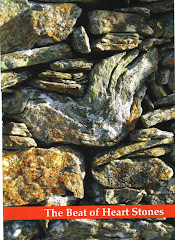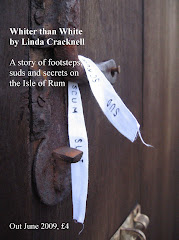
The Scottish Writers' Centre recently asked me to run a workshop on creative non-fiction writing (CNF). It was an interesting thing to do as I consider myself quite new to the genre and still discovering what it means. I had to think about it quite hard.
In the US, there’s a Journal dedicated to CNF, and you can now do a Masters in it in Britain. But arguably it’s nothing new. It’s writing about people, places, and ideas. It can include personal essay or memoir, biography, travel, sports or nature writing. Through this form the writer communicates factually accurate information but simultaneously delivers it in a style and form that resembles poetry or fiction. It must have both. And I know it when I read it -- Barry Lopez, Christopher Rush, WG Sebald, Iain Sinclair, Norman Lewis. And I certainly found it in spades when I was editing A Wilder Vein.
In the workshop, we went through a series of steps. First we wrote briefly about an episode from personal memory, capturing the events and making it vivid with sensual, observed details. I encouraged a kind of outspokenness in the voice which it seems to me the writing of non-fiction may need in order to succeed. As Allan Massie has said, ‘Character is a key word, for the good essay – or column – always reveals something of the author’s personality. That is part of its charm. It follows that the essayist must have a personality worth being acquainted with’. (The Author, Winter 2009). Personally I find that quite a scary challenge.
Next we discussed the factual content, and made a list of research questions we would have to pursue in order to ground our 'essay' in tangible evidence of place, people, the self, and events.
CNF may also draw on filmic devices. Barbara Lounsberry argues in The Art of Fact that ‘the scene’ is a key element of realising a vivid account. The sequencing of scenes also determines the shape and structure of the piece, or ‘the plot’. We might jump cut between scenes. A scene concludes when X threatens Y with violence. Rather than dramatising the actual scene of violence next, the scene that follows might reveal X in hospital (rather than Y). In keeping with the filmic parallel, I got the participants using storyboards to map out a route through their material, highlighting only the scenes which they would lavish with the detail needed to dramatise them, and finding the best sequence to deliver the story. They also needed to have their characters arrive in any scene with a clear motivation.
Finally we looked at literary qualities -- the artistry involved in creating pace and tension; the use of metaphor; creating rounded characters, etc.
At the end I found I had puzzled myself. Nearly all these elements are at play when I write fiction. It would be rare for me to write a short story without considerable research. It might generate a central metaphor or ground my characters in their worlds. I need enough insight about how architects work, for example, to be able to understand how my architect character would feel about a crack appearing in the ceiling of his own home. Bernard Mac Laverty calls fiction 'made-up truth', something my gut agrees with. Arguably both forms are dealing with truth. So is the real difference then in the dedication of CNF to facts which are not imaginatively generated?
Last year, Zadie Smith wrote a piece for the Guardian Review about novelists writing essays, around the time her own book of essays was published. In the piece she reflected on 'truthiness' and artistry, and said: ‘…an essay is an act of imagination, even if it is a piece of memoir. It is, or should be, “ a form of thinking, consciousness, wisdom-seeking” but it still takes quite as much art as fiction. Good non-fiction is as designed and artificial as any fairy story.’
I've reflected elsewhere on what prompted me to write non-fiction about walking. Now that I've done a bit of it, what is knocking about in the back of my mind, as the most significant difference for me between fiction and CNF writing, is the sense of a very different starting point. I might set out to write a short story with only an image of a diesel-soaked piece of clothing. It’s a feeling, a sense of being grabbed, a conviction that I’m onto something that I don’t yet understand. The remainder of the story will gradually materialise around it, attach to it, develop meaning. It's a mysterious process. In non-fiction, I feel a clearer menu of fact, observation, and meaning to select from and develop, a more deliberate sense of artistry involved in the arrangement of the parts.
In the US, there’s a Journal dedicated to CNF, and you can now do a Masters in it in Britain. But arguably it’s nothing new. It’s writing about people, places, and ideas. It can include personal essay or memoir, biography, travel, sports or nature writing. Through this form the writer communicates factually accurate information but simultaneously delivers it in a style and form that resembles poetry or fiction. It must have both. And I know it when I read it -- Barry Lopez, Christopher Rush, WG Sebald, Iain Sinclair, Norman Lewis. And I certainly found it in spades when I was editing A Wilder Vein.
In the workshop, we went through a series of steps. First we wrote briefly about an episode from personal memory, capturing the events and making it vivid with sensual, observed details. I encouraged a kind of outspokenness in the voice which it seems to me the writing of non-fiction may need in order to succeed. As Allan Massie has said, ‘Character is a key word, for the good essay – or column – always reveals something of the author’s personality. That is part of its charm. It follows that the essayist must have a personality worth being acquainted with’. (The Author, Winter 2009). Personally I find that quite a scary challenge.
Next we discussed the factual content, and made a list of research questions we would have to pursue in order to ground our 'essay' in tangible evidence of place, people, the self, and events.
CNF may also draw on filmic devices. Barbara Lounsberry argues in The Art of Fact that ‘the scene’ is a key element of realising a vivid account. The sequencing of scenes also determines the shape and structure of the piece, or ‘the plot’. We might jump cut between scenes. A scene concludes when X threatens Y with violence. Rather than dramatising the actual scene of violence next, the scene that follows might reveal X in hospital (rather than Y). In keeping with the filmic parallel, I got the participants using storyboards to map out a route through their material, highlighting only the scenes which they would lavish with the detail needed to dramatise them, and finding the best sequence to deliver the story. They also needed to have their characters arrive in any scene with a clear motivation.
Finally we looked at literary qualities -- the artistry involved in creating pace and tension; the use of metaphor; creating rounded characters, etc.
At the end I found I had puzzled myself. Nearly all these elements are at play when I write fiction. It would be rare for me to write a short story without considerable research. It might generate a central metaphor or ground my characters in their worlds. I need enough insight about how architects work, for example, to be able to understand how my architect character would feel about a crack appearing in the ceiling of his own home. Bernard Mac Laverty calls fiction 'made-up truth', something my gut agrees with. Arguably both forms are dealing with truth. So is the real difference then in the dedication of CNF to facts which are not imaginatively generated?
Last year, Zadie Smith wrote a piece for the Guardian Review about novelists writing essays, around the time her own book of essays was published. In the piece she reflected on 'truthiness' and artistry, and said: ‘…an essay is an act of imagination, even if it is a piece of memoir. It is, or should be, “ a form of thinking, consciousness, wisdom-seeking” but it still takes quite as much art as fiction. Good non-fiction is as designed and artificial as any fairy story.’
I've reflected elsewhere on what prompted me to write non-fiction about walking. Now that I've done a bit of it, what is knocking about in the back of my mind, as the most significant difference for me between fiction and CNF writing, is the sense of a very different starting point. I might set out to write a short story with only an image of a diesel-soaked piece of clothing. It’s a feeling, a sense of being grabbed, a conviction that I’m onto something that I don’t yet understand. The remainder of the story will gradually materialise around it, attach to it, develop meaning. It's a mysterious process. In non-fiction, I feel a clearer menu of fact, observation, and meaning to select from and develop, a more deliberate sense of artistry involved in the arrangement of the parts.
But to be honest, I'm still puzzling.




3 comments:
A fabulous article, Linda. I so agree with all your points. Sometimes there's more truth in fiction than in a factual piece because of the *feelings* conveyed. Can be dangerous, though, by emphasising the wrong feelings or bringing out unexpected feelings - completely inadvertently - for sensitive readers.
Thanks Bern, but I've just read Kapka Kassabova being much more inteersting than me on this in the Scottish Review of Books, see http://www.scottishreviewofbooks.org/index.php?option=com_content&view=article&id=368:diary-kapka-kassabova&catid=37:volume-6-issue-4-2010&Itemid=86
That's a helpful way of looking at it... I had always wondered about creative non-fiction :)
Neezes
http://wordingtheimage.blogspot.com/
p.s. I love your short stories!
Post a Comment